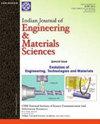Effect of water and mercury quenching on microstructure and mechanical behavior of room temperature rolled Zircaloy-2
IF 0.6
4区 工程技术
Q3 ENGINEERING, MULTIDISCIPLINARY
Indian Journal of Engineering and Materials Sciences
Pub Date : 2022-01-01
DOI:10.56042/ijems.v29i4.47288
引用次数: 0
Abstract
The present study investigates the effect of water and mercury quenching on the microstructural and mechanical behavior of room temperature rolled Zircaloy-2. Solution treatment of Zircaloy-2 at 1073 K followed by quenching in mercury and water has been performed prior to rolling. Different reduction from 25% to 85% of the quenched alloy and further characterization has been performed by tensile testing, Electron back scattered diffraction (EBSD) and Transmission Electron Microscopy (TEM). Enhanced tensile strength (745 MPa) after 85% rolling reduction was obtained compared to 389 MPa after water quenching. Rolling reduction results an increase in the dislocation density, thereby enhancing the mechanical strength. Initial deformation has been observed by the activation of extension twinning from EBSD microstructure. Twinning results the inclination of ‘c’ axis towards the normal direction which makes near basal grains orientation along the deformation direction. Due to hard orientation i.e. ‘c’ axis aligned along the loading direction, the grain fragmentation is heterogeneous. Grain fragmentation leads to improvement in the ductility with minimal loss in strength owing to rearrangement of dislocations after annealing at 400 o C for 30 minutes. By optimizing the annealing temperature (400 o C for 30 minutes), bulk ultrafine grained Zircaloy-2 have been produced in 85% room temperature rolled Zircaloy-2.水和汞淬火对室温轧制锆合金组织和力学行为的影响
研究了水和汞淬火对室温轧制锆合金的组织和力学行为的影响。在轧制前,对锆合金2进行1073 K的固溶处理,然后在汞和水中淬火。通过拉伸测试、电子背散射衍射(EBSD)和透射电镜(TEM)对合金进行了进一步的表征。与水淬后的拉伸强度389 MPa相比,水淬后的拉伸强度提高了85%,达到745 MPa。轧制压下导致位错密度增加,从而提高了机械强度。通过激活EBSD组织的扩展孪晶观察到初始变形。孪晶使“c”轴向法向倾斜,使晶粒沿变形方向接近基底取向。由于硬取向,即“c”轴沿加载方向排列,晶粒破碎是不均匀的。在400℃退火30分钟后,由于位错重排导致的强度损失最小,晶粒破碎导致延性改善。通过优化退火温度(400℃,30分钟),在85%室温轧制锆合金中制备出了块状超细晶粒的锆合金。
本文章由计算机程序翻译,如有差异,请以英文原文为准。
求助全文
约1分钟内获得全文
求助全文
来源期刊

Indian Journal of Engineering and Materials Sciences
工程技术-材料科学:综合
CiteScore
1.70
自引率
11.10%
发文量
57
审稿时长
9 months
期刊介绍:
Started in 1994, it publishes papers in aerospace engineering, mechanical engineering, metallurgical engineering, electrical/electronics engineering, computer science and engineering; civil engineering, environmental engineering, heat transfer, fluid mechanics, instrumentation, and materials science.
 求助内容:
求助内容: 应助结果提醒方式:
应助结果提醒方式:


